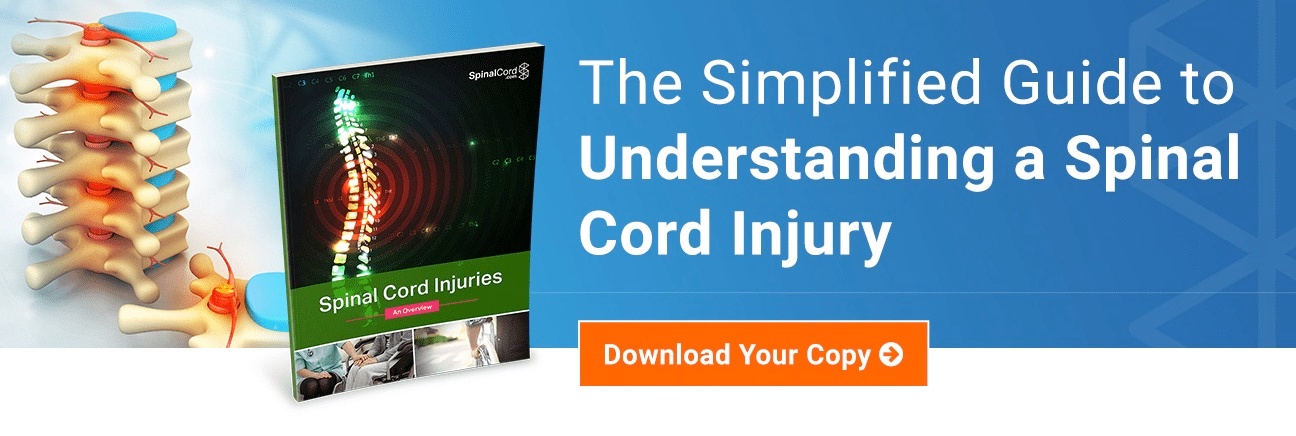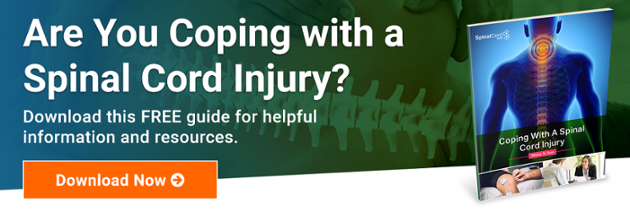What to Know as a Recent SCI Survivor
If you recently suffered a traumatic spinal cord injury (SCI), there is a lot of new information that you will need to quickly learn to stay informed about your injury and what it means to your prognosis and spinal cord injury recovery.
At Spinal Cord, it is our goal to help people with spinal cord injuries and their families have the best information possible available at their fingertips. As such, we’ve put together a list of some of the top things you should know as a recent SCI survivor:
What to Know about the Spinal Cord
The spinal cord is a bundle of nerve fibers and tissue that are located within the spine (the vertebral column that runs down your back), as well as the nerves at the base of the spine. It is responsible for a number of functions within the body. For example, along with the brain, the spinal cord is part of your central nervous system, which is responsible for sending signals between the brain and the rest of your body, as well as automatic musculoskeletal reflexes.
The cord and any injuries to it are divided into sections based on their correlation with the spine (from top to bottom):
- Cervical Spinal Cord: This section of the spinal cord, which is known as C1-C7, is located at the top of the spinal column and is the neck portion of the cord. There is an additional injury level, known as C8, which corresponds with damage to the spinal cord root located between vertebrae C7 and T1. Injuries to this region are the most severe and frequently result in fatalities. A C6 injury can result in loss of sensation or function below the top of the ribcage. However, while a cervical spinal cord injury can’t be reversed, some SCI survivors have still regained some level of recovery through treatment.
- Thoracic Spinal Cord: The next section down is the thoracic spinal cord. Ths area is known as T1-T12. While thoracic injuries are severe, they typically are not fatal but do require immediate treatment. SCI survivors with these injuries tend to have a good prognosis and can live independently with minimal modifications.
- Lumbar Spinal Cord: The lumbar spinal cord, known as L1-L5, is located in the lower back below the thoracic region. This is the area that has an inward curve just above your hips. Injuries to this level typically affect the hip and groin areas of your body, as well as other areas. Learn more about lumbar spinal cord injuries in our other lumbar spinal blog post.
- Sacral Spine: This triangular bone, located at the end of the lumbar spine, is known as S1-S5. Unlike the aforementioned regions, this section does not contain spinal cord; rather, nerve roots exit each of the remaining vertebral levels and affects nerve communication to the lower body.
The Types of Spinal Cord Injuries
Now that we’ve covered the levels of injuries, it’s time to discuss the two categories of spinal cord injuries.
- Incomplete: This type of spinal cord injury is one in which the spinal cord is partially severed or impeded. This means that you may retain some sensory and motor functions below the injury site (depending on the location and extent of your injuries).
- Complete: This type of injury results from a complete severance of the spinal cord. Unlike an incomplete injury, it means that sensory and/or motor functions below this injury site on the spinal cord are eliminated. However, it may be possible to regain some function through physical therapy and treatment.
Additionally, depending on your level and severity of injury, as well as the treatment you receive, you may experience temporary or permanent paralysis, which is a partial or complete loss of movement.
The two most common forms of paralysis include:
- Paraplegia: This is paralysis of the body below the waist, including both legs.
- Quadriplegia (also known as tetraplegia): This is a complete loss of movement in your hands, arms, legs, feet, and torso.
Spinal Cord Injury Treatment Options
Depending on the level of your injury and its severity, there are a variety of conventional and experimental treatment options available that recent SCI survivors and long-term survivors have had success with over the years. Luckily, there are spinal cord injury rehabilitation centers and ABT centers located throughout the U.S.
Some of the traditional methods include:
- Traction;
- Surgery that aims to:
- Decompress the spinal cord,
- Fuse together segments around the injury, or
- Remove foreign objects or bone fragments that may be impeding the spinal cord;
- Physical Therapy (PT);
- Occupational Therapy (OT);
- Activity-Based Therapy (ABT);
- Stem Cell Therapy;
- Functional Electrical Stimulation (FES) Therapy; and
- Virtual Reality (VR) NeuroTherapy.
The Cost of an SCI
Did you know that the average yearly costs after a high tetraplegia SCI in the first year alone is $1.079 million? And, each year that follows averages costs of more than $187,443. This isn’t pocket change. Depending on your level of injury, health, and age, that could mean that your costs will be upwards of several million dollars over the span of your lifetime.
Considering that the majority of spinal cord injury causes are automobile accidents, someone else may be liable for your injuries due to negligence.
Legal Options for SCI Survivors
There are a variety of things you’ll need to know about the legal system with regard to spinal cord injuries. However, the good news is that an experienced, knowledgeable, and caring spinal cord injury lawyer can help. A reputable spinal cord injury attorney can help you hold the person or company who is responsible for your injuries accountable by seeking legal justice and compensation, including lost wages.
You Are Not Alone
Lastly, although it often may feel like it, it’s important to remember that you are not alone. There is an entire community of spinal cord injury survivors like you who have gone through a life-altering spinal cord injury. Through this community, they have developed friendships and share their stories, experiences, and knowledge with other SCI survivors.
Learn more about how to cope with a spinal cord injury as a recent SCI survivor. Click on the image below to access our free guide.
Stay Updated on Advancements On Traumatic Brain &
Spinal Cord Injuries
About the Author






